How to tighten plastic windows for the winter. How to tighten plastic windows so that it doesn’t blow - we adjust the windows ourselves
For the manufacture of windows, the most common material is PVC profile. Products on the market are represented by many manufacturers; systems differ in the functionality of the fittings, design, purpose and shape.
Plastic windows serve for many years; they are highly resistant to climatic conditions, including temperature changes. But in order for the profile to really serve for a long time, it is necessary to ensure proper operation throughout its entire service life, that is, it is important to adjust the window correctly. Read below about the technique and rules for setting up a plastic window.
Pros and cons of plastic windows
The assembly and installation of such windows is considered a simple process, and the quality of the work performed depends on the specialist himself, who must follow the correct installation technology. The quality and durability of double-glazed windows made from PVC profiles depend on the fittings, manufacturer and characteristics of the raw materials used to produce the systems.
Advantages of plastic windows
Excellent soundproofing of rooms from annoying noise from the street;
The low thermal conductivity of double-glazed windows allows you to save on heating; when compared with the glass of old wooden windows, the savings will be at least 20%.
Plastic windows are highly airtight, which protects the premises from air flows from the street. There is no need to carry out insulation every year when the cold comes;
A plastic window can be used for up to ten years, and with proper installation, maintenance of fittings and other structural elements, the service life increases several times;
Plastic windows are protected from ignition and combustion;
Plastic windows are highly aesthetically attractive. The consumer can choose any shade and color of the window. Plastic windows are also easy to clean;
The surfaces do not need to be painted, nor do they require special care;
Modern plastic windows are multifunctional. They can be ventilated, placed Mosquito nets, which protect the house from various insects.
Like any other products, plastic windows still have their drawbacks:
In summer, especially in the heat, the profile expands, and in winter it narrows, due to which experts recommend adjusting the pressure every season;
Plastic windows cannot maintain and regulate the required temperature and humidity in the room, unlike a wooden profile;
Operating a window also requires lubricating moving parts, cleaning and changing the seal if necessary.
Despite the existing shortcomings, plastic structures are in demand throughout Russia, primarily due to high technical characteristics and low cost.
Components of a plastic window
Before you start studying the pressure settings of plastic windows, it is important to understand what elements the structure is made of:
Read also: Bamboo wallpaper in the interior: features of the material, the correct technique for gluing bamboo wallpaper
Valves;
Double-glazed windows;
Elements of fittings;
Parts for strengthening, protection and sealing;
Vertical/horizontal profile;
Profiles for connecting sashes.
The double-glazed window frame consists of a plastic profile, inside of which there is a reinforcing steel fastener. The window profile is joined together using special welding, the strength of which is reliable and undergoes testing and inspection. The steel and plastic profiles are connected with self-tapping screws. The frame, that is, the frame must have high strength in order to withstand all kinds of loads.
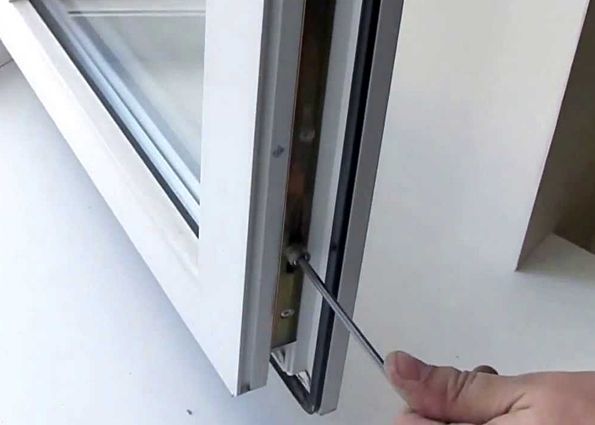 The interior of the doors also consists of a steel profile. The main role of the sashes is to ensure the correct performance of the window during opening and closing. Canopies, handles and other steel parts are classified as fittings. The fittings of a plastic window are responsible for its opening and closing, as well as ventilation. When a customer chooses a plastic window, he should pay attention specifically to the fittings, since the durability of double-glazed windows made from PVC profiles as a whole depends on the quality of this element.
The interior of the doors also consists of a steel profile. The main role of the sashes is to ensure the correct performance of the window during opening and closing. Canopies, handles and other steel parts are classified as fittings. The fittings of a plastic window are responsible for its opening and closing, as well as ventilation. When a customer chooses a plastic window, he should pay attention specifically to the fittings, since the durability of double-glazed windows made from PVC profiles as a whole depends on the quality of this element.
A double-glazed window is a profile detail that lets light into the house, that is, glass. Plastic windows come with several double-glazed windows, it all depends on the shape and design of the window. If there are two glasses in a double-glazed window, it means that they form 1 air chamber. A special substance consisting of gas is usually pumped inside the chamber. It is this substance that can suppress sounds and extraneous noise, as well as retain heat. Manufacturers use plastic beads to hold the glass on the window frame.
 For additional tightness of a plastic window, manufacturers use a seal. It protects the room from cold air flow and humidity. An impost can also be installed if the profile consists of several parts. Imposts are made from plastic or anti-corrosion steel. A plastic impost creates freedom for the window opening, and a steel impost is fixed in the opening.
For additional tightness of a plastic window, manufacturers use a seal. It protects the room from cold air flow and humidity. An impost can also be installed if the profile consists of several parts. Imposts are made from plastic or anti-corrosion steel. A plastic impost creates freedom for the window opening, and a steel impost is fixed in the opening.

Important points for adjusting the pressure of a plastic window
Plastic windows come in different varieties, so it is not surprising that there is huge selection window profile. Windows are distinguished by the number of double-glazed windows, strength, material, quality and other characteristics. Each manufacturer has its own nuances for adjusting plastic window fittings.
The adjustment mechanism is useful if problems arise during the use of the plastic profile:
1. A draft occurs. When the window profile allows air masses to pass through when closed, it is necessary to repair the clamp.
2. If the frame engages the lower element of the sash, then sagging adjustment is required.
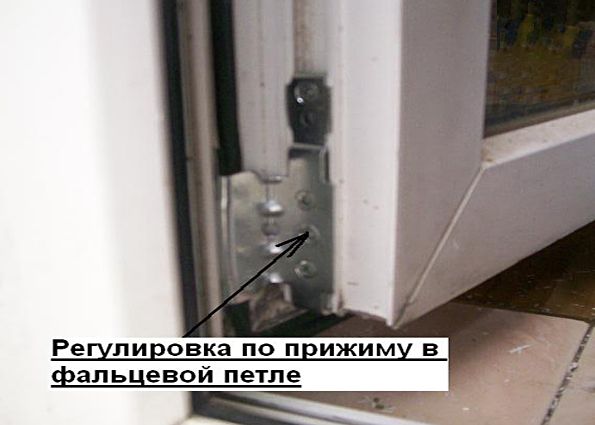 3. If the handle is loose or not securely fastened, it is necessary to replace the location of the plate located inside the handle.
3. If the handle is loose or not securely fastened, it is necessary to replace the location of the plate located inside the handle.
Read also: Blooming wallpaper (thermal wallpaper) – magic is nearby
4. If the handle is very tight or does not turn well, it is necessary to lubricate the fittings or replace the location of the sash.
Pressure adjustment technology and necessary tools
Installation and adjustment of plastic windows is carried out by professionals, but if you follow a certain mechanism and technology, you can do it yourself, without the help of specialists. When adjusting a plastic window, you will need a four-millimeter hex key, as well as installation instructions. If a window breaks due to the fault of an installation specialist or due to long-term use, the damage is eliminated by replacing faulty parts or by additionally repairing them.
 There are several adjustment modes depending on the type of problem. The horizontal direction of regulation allows you to eliminate minor bevel or frame shift. To do this, you need to get to the lower and upper hinges, which are equipped with holes for mounting a hexagon. During the process, you must strictly adhere to the instructions, failure to comply with which can damage the mechanisms. If the hexagon rotates in a clockwise direction, then the structure is pressed against the sash; otherwise, the fasteners between the sash and the window must be loosened and the lower part lowered.
There are several adjustment modes depending on the type of problem. The horizontal direction of regulation allows you to eliminate minor bevel or frame shift. To do this, you need to get to the lower and upper hinges, which are equipped with holes for mounting a hexagon. During the process, you must strictly adhere to the instructions, failure to comply with which can damage the mechanisms. If the hexagon rotates in a clockwise direction, then the structure is pressed against the sash; otherwise, the fasteners between the sash and the window must be loosened and the lower part lowered.
If the top hinge fails, you must open the window completely and move the hinge approximately 2 mm. Adjusting the window in a vertical position requires the use of a hinge at the bottom. On the hinge you need to open the valve, under which there is a hole for the key. Moving the key clockwise allows the sash to rise, moving the key in the opposite direction causes it to lower by 2 mm.

Plastic window pressure adjustment mechanism
If a window breaks or fails, it is not at all necessary to completely replace it. Such problems can be easily solved by adjusting them. Adjusting the pressure of a plastic window effectively eliminates the cause of drafts and heat loss in winter.
You can understand that you need to adjust the sash pressure by holding a lit match to the closed window. If the fire does not tremble, then adjustment is not needed, but if it moves or goes out, you cannot do without it.
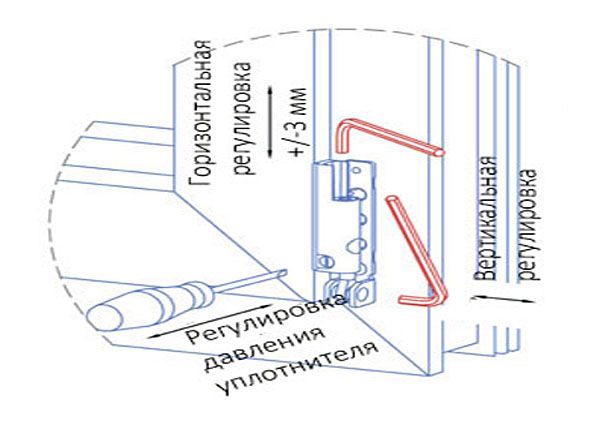 Self-adjustment of double-glazed windows from a profile will take little time. To do this, you need to adjust the fitting eccentrics, which are located behind the handle parts. Press the eccentric firmly against the surface of the frame, moving in a clockwise direction. There is usually an indicator on the eccentric itself that helps you understand how well the plastic window sashes are pressed against the frame.
Self-adjustment of double-glazed windows from a profile will take little time. To do this, you need to adjust the fitting eccentrics, which are located behind the handle parts. Press the eccentric firmly against the surface of the frame, moving in a clockwise direction. There is usually an indicator on the eccentric itself that helps you understand how well the plastic window sashes are pressed against the frame.
To adjust plastic windows, special plates and pliers are also used, which are installed by the manufacturer on the sashes. Its offset can be adjusted by 1 mm. Adjustment of the weakening of the window pressure is usually carried out in the summer, and in the winter the pressure is increased. However, the durability of a plastic window is longer if the clamp is in free mode.
Read also: We carry out restoration of interior doors with our own hands
The window instruction manual supplied by the manufacturer usually contains detailed information about correct pressure adjustment. The instructions are the same for almost all windows.
To increase the clamping density, you need to turn the hex key to the left by 3 mm. First, open the window; in this position, the end, which has three eccentrics, is clearly visible. If the screw is tightened too much, the seal can be damaged, so it is important to install the eccentrics in the same position.
If you are adjusting the window for the first time, you do not need to do it to the maximum. In case of prolonged use of the profile, it is necessary to increase the adjustment due to wear of the rubber bands, which occurs due to the constant opening and closing of the plastic window. Replacing a worn seal and installing it is also quite simple. It is worth choosing a high-quality seal, otherwise it may cause drafts in the future.

Advice from experts on the operation and repair of plastic windows
If the handle on the window is broken or does not move well, turn the fittings at an angle of 90 degrees, disconnect the fasteners, turn the plates in the opposite direction and evaluate its suitability. If the handle is broken, it must be replaced with a new design. It is advisable to purchase a product of the same brand that was originally installed.
If the seal fails even after adjustment, the best option- replace it. It is necessary to loosen the seal as much as possible, remove it and replace it with a new rubber band. Typically, the seal needs to be changed once a decade, because it is wear-resistant and does not require special care. If the seal sticks, lubricate it with machine oil. If the window is used in a standard manner and the adjustments are made correctly, the seal will last a long time.
If you adjust the faults yourself, but the problems cannot be eliminated efficiently, it is best to contact professionals who will eliminate the cause quickly and inexpensively. It is important to find out about the problem that arose during the operation of the window on time, as this will save time and money on repairs.
Perhaps the most important condition for the long-term wear resistance of plastic windows is the process of their use. All fittings, parts and window elements must be properly configured. You cannot wash windows with solutions and products that are not suitable for this. It is recommended to clean a plastic window with water to which you add a little soap.
How to tighten plastic windows so that there is no draft from the sash? This question interests every owner of an opening double-glazed window. Indeed, in the cold season, even a small gap between the double-glazed window and the frame leads to a loss of comfort in the house.
How does the double-glazed window sash mechanism work?
A plastic window consists of a polymer frame (sometimes with a sash), a multilayer package assembled from 2-3 glasses separated by a void (air is the best heat insulator) and a mechanism that ensures the opening and closing of the window.
The mechanism of the sash allows you to open it by turning it on its hinges, or tilt it back, opening it at a precisely adjusted angle. To ensure these actions, the following components are included in the double-glazed window mechanism:
- The top hinge is a complex element that provides both rotation and tilting.
- The bottom loop is a simple element that provides only rotation.
- The lock is a complex unit that both locks the sash and adjusts the functionality of the top hinge.
How the window will work - tilt or open - is decided by the constipation. When its handle (lever) is moved down, parallel to the side of the frame, the window closes tightly. Rotating the lever 90 degrees unlocks the swinging function - the window can be opened by pulling the handle towards you. Rotating the lever 180 degrees unlocks the tilting mechanism - the window will open slightly under its own weight or due to muscular force.
When do you need to adjust the window sash?
Firstly, adjustment is needed in case of errors during window installation. Insufficiently qualified craftsmen may make a mistake when checking the horizontal or vertical alignment of the glass unit, after which the sash will begin to scratch the frame. In this case, you will need a 2-3 mm adjustable gap in height and width.
Secondly, adjustment will come in handy after several years of window operation, when the seals lose their elasticity or simply wear out. The sash will be pressed against the frame, but the worn seal will no longer seal the joint. Then the millimeter adjustable clamping gap will come in handy.
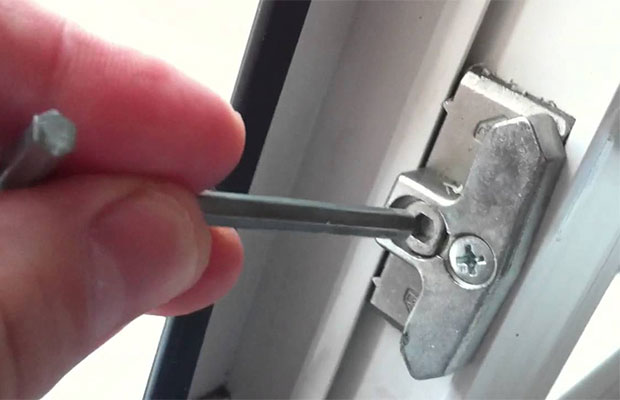
Thirdly, manual adjustment of the gaps will be needed when the seasons change. In winter, everyone wants perfect tightness of the joints (so as not to blow), and in the summer, no one will refuse a slight draft.
Moreover, even in winter, before tightening the plastic windows, it is necessary to provide for the existence of a ventilation gap that ensures the flow of fresh air into the insulated room. Therefore, further in the text we will look at adjusting windows that blow either too much or too little.
Preparing a window for winter: how to adjust a plastic window so it doesn’t blow
If the sash scratches the frame, then in winter there is a blow from the window due to the distortion of the structure. To eliminate this drawback, you will have to do the following: slam the window and lock it with the handle. After this, grab the edge of the sash with both hands and pull it towards you, without offering much force. If it moves out of place at the bottom, then you have a loose bottom hinge. If it's at the top, you have problems with the top hinge.
After localizing the location of the displacement, you need to start eliminating the distortion. The loop at the bottom is adjustable both vertically and horizontally. The upper mechanism can be adjusted in the same way. The tool usually used is a 4mm hex wrench. Sometimes a cross-head screwdriver or a special star wrench included in the window delivery kit is used.
To adjust horizontally, open the sash and insert the key into the groove located at the bottom of the hinge. Turning clockwise brings the glass unit closer to the hinge, turning in the opposite direction moves it away.
Vertical adjustment of the lower hinge is performed differently: the window is opened slightly, tilted into the room, the key is inserted into the groove located in the end part of the curtain. Turning clockwise raises the sash, turning in the opposite direction lowers it. After completing the adjustment, you can close the window and check whether the sash moves away from the frame or not.
The hinge at the top of the window is adjusted slightly differently. To do this, you need to open the window 180 degrees and get to the adjusting screw located on the side edge of the sash, in the area of the top hinge. Next, insert a key into the head of the screw and turn it a quarter turn. After this, close the window and check the degree of pressing of the sash again. If necessary, the operation is repeated.
If the screw at the top hinge does not help, then it is necessary to adjust another unit, which is located in the area of the tilt mechanism plate that holds the window in an inclined position. To do this, open the sash and, holding the lock, tilt it back, gaining access to the plate at the top of the window. Next, insert a key into the head of the screw and turn it a quarter turn clockwise or in the opposite direction.
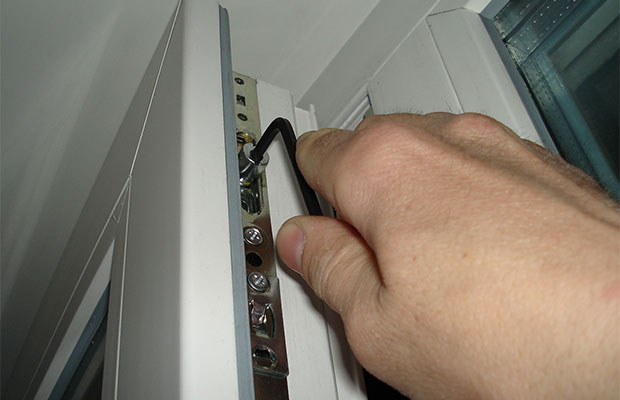
To get to the tilt mechanism plate, you need to do the following: turn the handle 90 degrees, open the window, press the lock with your finger and turn the handle up 180°. After this, the open sash will tilt towards the room, exposing a plate with an adjusting screw.
If the sash closes easily and without squeaks and does not move when closed, but there is still a draft coming from the windows, tighten the clamp of the glass unit to the frame. To do this, do the following:
- Open the frame and turn the locking handle down. In this case, part of the metal pins protruding from the sash moves out of place. These parts must be marked with a felt-tip pen.
- Next, you need to take pliers (for smooth surfaces) or a flat-head screwdriver (for a slot) or a hex key (for an internal recess) and sequentially turn the pins so that they most of moved towards the seal.
Typically, to create additional clamping force, the pins are turned clockwise half a turn. Moreover, until the manipulations with all the pins that move when the handle is closed are completed, the sash should be kept open. You will be able to evaluate the results of your efforts only after completing this work. Otherwise, the window will warp on the locking elements.
Adjustment does not help - change the seals
In particularly difficult cases, in order to eliminate an unwanted draft, in addition to adjusting the sash mechanism, it is necessary to resort to replacing the seals. To do this, you need to open the window and fix the sash. Next, grab the seal and pull it towards you. With enough effort it will come out of the groove very easily.
The next stage is the installation of a new seal. It starts with cutting to size. Moreover, the old seal acts as a template, so it cannot be stretched when dismantling. After trimming, the new material is pressed into the groove and checked for creases and other defects.

According to manufacturers' recommendations, such a replacement should be done no more than once every 10 years, but the seal could be installed unevenly or damaged due to use. Typically, the main cause of damage to the seal is abuse of the sash pressure setting. Therefore, sometimes it is changed before the end of the 10-year period.
If the seal squeaks, then instead of replacing it, you should try silicone grease - it will eliminate the unpleasant noise. In this case, it is strictly not recommended to use machine oil.
Preparing a window for summer: how to create a light draft
Before this, we figured out how to tighten the hinges on plastic windows so that cold air does not blow from the sash. Now we have to solve another problem - to create a light draft that will blow through the stuffy room. To do this you need to do the following:
First, find the trunnions on the side surface of the sash - the moving parts of the clamping mechanism. Their details protrude above the surface more than other elements.
Secondly, inspect the trunnions and find eccentrics - special screws screwed into the trunnions with a center offset. They will give themselves away not only by their slightly uneven location, but also by the presence of marks (marks) on the screw head.
Third, turn the off-center screw in the desired direction. The standard position of the eccentric is exactly in the center of the trunnion, which gives a medium-pressure force. However, in summer we need the weakest clamp so that fresh air can enter the apartment. Therefore, we rotate the eccentric so that its smaller side faces the rubber band (seal). Typically, this is done by turning the screw counterclockwise by half or a quarter of a turn.
The described operation will have to be done with all the trunnions, setting the eccentric marks in one direction, otherwise the sash will begin to mow when locked, and its mechanism will wear out prematurely.
Plastic windows are popular for a reason. They have a number of advantages, such as durability, excellent noise absorption, heat and sound insulation. They are easy to wash. An important criterion is also the affordable price of the product. If old wooden windows had to be constantly tinted and insulated for the winter, then with plastic analogues everything is much simpler.
The plastic from which the frames and sashes are formed is attractive in appearance. It has a white, smooth, glossy surface. There is no need to paint it. Insulated. If your window installation was carried out correctly, then immediately after its installation you will feel the difference: street sounds will become much quieter, the apartment will become warmer, and the air will stop blowing from the window.
By following simple rules for operating windows, provided that you have installed quality product, you can use them for a long time. Usually, after installation, the representative of the company who installed the structure gives a short briefing to the residents of the apartment.
A self-respecting company must provide warranty obligations for a certain period of time: from one to three years. In addition, the company’s specialist will recommend that you contact them if any problems arise with operation: both those and those that are not subject to.
Of course, if a serious breakdown occurs, it is best to turn to specialists. But there are types of operations that you can do yourself without outside help, for example, adjusting plastic windows. No special skills are required, but you need to stock up on a simple tool.
To work, depending on the brand of fittings installed on your window, you will need to purchase:
- Screwdriver Set;
- A set of star keys;
- Pliers;
- Hex screwdrivers.
All errors that can be corrected by adjusting plastic windows with your own hands can be divided into four types:
- Blowing It occurs due to a loose fit of the window sash to the frame. The problem can be solved by adjusting the clamp.
- Clinging to the frame of the bottom of the window sash. Most often this happens as a result of sagging sash. The error can be corrected by adjusting the horizontal and vertical regulators, which are located in the loops.
- When moving, the central sash touches the frame. Horizontal and vertical adjusters on hinges are adjustable.
- Broken handle, loose fit. Replacing fittings or adjusting their fastening.
Working with window fittings
Adjustment of plastic window fittings is carried out in several places.
Adjusting the end horizontal adjusting screws in the upper and lower curtains
By adjusting them, you can slightly change the position of the sash relative to the frame. This setting adjusts the horizontal position of the sash relative to the window sill. The screws are located in the area of the metal hinges. They have a horizontal orientation, that is, the screws are placed parallel to the window sill. Depending on the brand that produces the fittings, adjustment can be made using a hexagon or a simple screwdriver.
Let's consider the sequence of actions:

Tip: Adjustment of the screws that are located on the bottom hinge can be done both in the closed position of the window and in the open position. When the sash is closed, the screw is adjusted from the outside, and when open, from the inside.
After carrying out the work, you need to check the result of the adjustment, and if everything is in order, close the hinges with a decorative cover.
With this setting, you can move the sash a distance of about 2 mm, in one direction or the other. Thus, you can correct the location of the sash and eliminate its distortion.
If you have difficulty determining what to turn where, try first watching a video on how to adjust plastic windows.
Setting the sash vertically
The adjusting screw is located on the lower canopy, at the top. To find it, you need to remove the protective cover. Adjustment is carried out using a hexagon. By turning it clockwise, you will raise the window; when turning it in the opposite direction, you will lower it.
Before you start making adjustments, remove the protective decorative covers from the hinges so as not to be distracted by them during work.
Setting eccentrics, adjusting the pressure of plastic windows
Cams are small metal heads that protrude slightly above the locking lock. They can be seen if you look at the end of the sash, where the locking mechanism is located. They are in their own way appearance look like small oval cylinders. The direction of the oval characterizes the force of pressing the sash against the frame.
There are three eccentric positions:

Tip: Some types of cams have an index groove that runs through the center of the cam. Its position relative to the axis also characterizes the pressing force.
The eccentric, when you turn the handle, goes behind a special plate and presses the sash against the frame. When you need to strengthen or weaken the pressing of the window sash to the frame, you need to move the eccentrics to the required position. In order to do this, you need to use pliers, a screwdriver or another tool (depending on the type of product).
Some types of eccentrics can be adjusted by hand; information about this should be in the instructions for adjusting plastic windows. To do this, you need to pull it back a little, turn it in the desired direction and release it. Under the action of the spring it will be pressed back against the sash.
By changing the position of the eccentrics, you achieve a change in the pressing force only in the area where the window handle and lock () are located. This adjustment is not enough. In order for the pressing to be uniform on all sides, it is necessary to adjust the pressing force on the other side, where the canopies are located. Clamping mechanisms are also located there.
In appearance, they look a little like records with triangle tongues. They are adjusted using hexagons. When the adjusting screw is rotated clockwise, the triangular liner moves outward. The more it protrudes above the surface of the base, the correspondingly stronger the pressure.
Experts advise regularly changing the clamping force depending on the season.
Strengthening the handle or replacing it
In order to put the dangling handle in place, you must first turn the decorative strip that covers the fasteners 90 degrees. Below it are the mounting screws. They should be tightened with a screwdriver.
The handle is replaced in the same way. Only first you need to completely disconnect it, that is, completely unscrew the screws. Then, in place of the old one, you need to screw a new handle. It is advisable to use the old holes for fasteners rather than try to drill new ones.
Even more information about handles for plastic windows, and about hardware manufacturers.
IN last years The spheres of construction and repair began to develop even more actively. A lot of innovative materials have appeared that amaze with their properties and qualities, and plastic windows are installed everywhere in our own houses and apartments, since they are much more reliable, protect from the cold more effectively, and their external aesthetic appearance is much more attractive than the old ones painted white , not very straight boxes. Naturally, wood is more environmentally friendly and safe, but a good quality window will not be cheap. But even PVC structures may require maintenance and repair over time in order to serve us faithfully for many years. So how can you tighten plastic windows yourself, and is it possible to do this without the help of a real specialist? This is exactly what our article will discuss.
Causes and Effects: When Window Adjustment May Be Required
First of all, plastic and metal-plastic windows can noticeably lose their quality after prolonged and merciless use, and if at the same time they have not yet received constant proper care and maintenance, they may become completely unusable and require replacement. It is better not to allow such options, because even a real beginner who has never dealt with repairs before, much less construction at all, can figure out how to tighten plastic windows, which is best demonstrated by the video.
Worth remembering
If the breakdown is not serious, and is not of a mechanical or functional nature, then absolutely any person on the street will be able to cope with the adjustment of the structure, since this will not require any special knowledge, much less education. With proper care, timely prevention and adjustment, PVC structures will last for many years without replacement, thereby saving your family budget.
However, before you figure out what you need to do first, you need to find out the main reasons that will force you to make some decisions and do something with your own hands. Of course, the easiest way is to call a specialist who will generally do all the manipulations quickly and easily, but his services will have to be paid quite generously. If you have extra funds, then there are no problems, then the question will be settled, but what can you do if you have no finances, and there is noticeable blowing from the window. In what cases is it worth picking up a screwdriver and pliers and getting to work?

- When installation without checking the vertical or horizontal level is not carried out accordingly, you will have to correct such defects by adjusting the frame.
- If the door leaf touches the frame, that is, it is simply sagging.
- When a draft is detected, which is not at all difficult to detect. To do this, just light a candle and carry it around the perimeter of the window. This way it will immediately become clear where the “siphon” comes from.
Another reason that will necessarily entail the need for adjustment is natural wear and tear of the structure. No matter how high-quality and technologically advanced plastic is, it is still subject to wear and tear, just like any other material. All that remains is to figure out how to tighten the plastic windows so that it does not blow, does not catch other parts of the structure, and so on.
Let's start with the basics: how to tighten fittings on plastic windows

To begin with, before you begin to study the issue, you need to finally understand what, in essence, this very fitting is that you are planning to regulate. This whole thing consists of several completely separate, however related friend with other nodes, thanks to which the smooth operation of each section of the mechanism is ensured.
For example, many craftsmen call the fittings on the sash a locking mechanism, and the one located on the frame a striker. Moreover, it is worth understanding that some problems, especially those that arose due to a violation of production technology or installation, cannot be eliminated on your own, so you always need to be prepared for the worst, but hope for the best.
Necessary tools
It is clear that before you start making adjustments or repairs, you will have to prepare in a very childish way and assemble all the necessary tools. You definitely won’t be able to do without some devices, but even if not everything from the proposed list is useful to you, then a new screwdriver or a tricky key at home won’t hurt, that’s for sure.
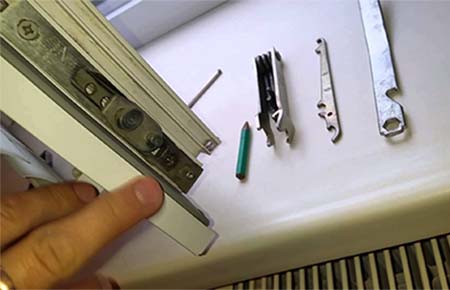
- Complete set of star type attachments.
- Set of hex keys.
- A special spatula, as well as a special spatula designed for working with double-glazed windows.
- Special linings for double glazed windows. They can be of different sizes, it would be advisable to take several.
- Curly and simple screwdrivers, as well as the most ordinary pliers or pliers.
- A soft brush, preferably chemical-resistant, and window lubricant, available at a hardware store.
It is worth understanding that it is better not to adjust windows on your own if all of them have not yet come out. guarantee period, since in this case no one will do anything for you for free. That is, with outside intervention, the warranty is simply void.
Locking mechanism: how to tighten locks on plastic windows
Everything here is quite simple, and if you notice that the locking mechanism prevents the window sashes from closing and opening freely, then it’s time to adjust the lock. Upon visual inspection, you will find that everything is visible there and the lock can be easily moved to the top, or, conversely, to the bottom.

Carefully loosen the screws that hold the lock, and then with a slight movement move the mechanism in the desired direction. You must be careful not to overdo it, as you will get the opposite effect. You can move the locks no more than a few millimeters so as not to make the problem even more serious.
The basis of the design: how to tighten the frame of a plastic window
The question here is so complex that it will take a long and very painful time to figure it out. The whole point is that we'll talk about the frame, which is also called an impost, which allows you to evenly distribute the load of the glass unit over the entire surface of the plastic frame structure. Moreover, it is worth understanding that there may be various design solutions here, on which the adjustment will depend.

Photo from the site: 10×15.by
In most cases, a steel impost is tightly welded to the profile, and is simply secured on top by the plastic sashes themselves. Then there is simply no talk of any adjustment, and repairs and adjustments will have to be left to professionals. However, if the frame is supported by end screws, then they can be found in the impost reinforcement chamber. By slightly twisting back and forth, you need to select the most acceptable position and that’s it.
How to tighten the handle on a plastic window
It also happens that the handle of a plastic window stops functioning as it should, becomes loose, and in general, it seems as if it is about to fall off. In addition, it can “catch” the mechanism every once in a while, or even not work at all. In this case, you will definitely need adjustment or, in extreme cases, replacement. And everything is much simpler than you might think.

- Turn the base of the handle, which can be metal or plastic, ninety degrees and you will see special screws that hold it in the desired position.
- After inspecting the fastening, try tightening the screws, this usually helps and nothing else is needed.
- If you need to replace the handle, the screws will have to be unscrewed, and then, replacing the spare part, screwed back into place.
It is worth knowing that in various designs with a handle, unforeseen circumstances may arise, for example, in the form of slipped plates with springs, latching tongues, and so on. If you visually see how you can solve the problem, then do it, but if it’s not clear what’s what, you should call a specialist. Among other things, it is worth considering that if the movement of the mechanism is quite harsh and it is difficult to turn the handle, it is worth lubricating all parts of the mechanism that are accessible using an oil can.
How to tighten rubber bands on plastic windows
Everything here is as simple as daylight and you shouldn’t invent unnecessary problems and difficulties for yourself. So, the question is cardinal, if the rubber bands and seals have stopped performing their function efficiently, then it must be replaced immediately, and there simply cannot be any other options. It’s definitely not possible to repair, revive, steam, etc., rubber bands, you shouldn’t listen to anyone, this is deliberately misleading you, especially since the cost of the seal is not so high that you would waste your own time and effort.
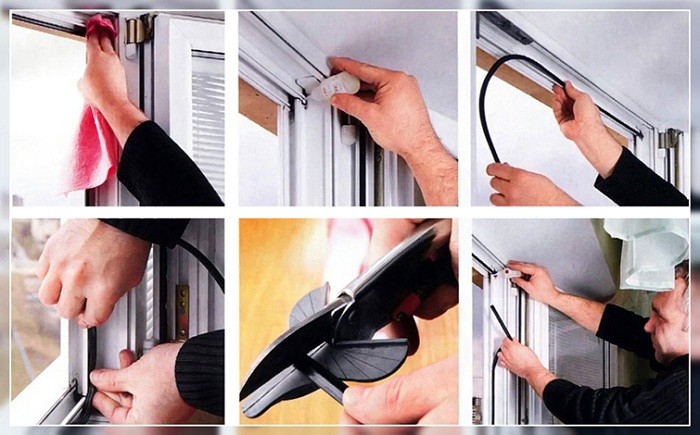
The old seal must be carefully removed from the special groove; it is immediately thrown into the trash, since it will be of no use anywhere else. New rubber bands must be placed in the same place, without stretching it at all. Moreover, it’s great that all rubber bands can and even need to be lubricated. The best choice for these purposes is silicone grease, which can be purchased at almost any store.
Correcting sagging: how to tighten hinges on plastic windows
First of all, you need to identify the problem, and its clearest confirmation can be a clear imbalance, which is visible to the naked eye. In addition, the window sashes, due to sagging and loose hinges, can touch, touch, and maybe even not allow the window to be closed or opened at all. All these factors must be taken into account, so as not to sadly wring your hands later.
Good advice
Before you figure out how to tighten plastic windows in general, as well as hinges in particular, you should make sure that they are not deformed. Moreover, even the slightest traces of such a phenomenon should be a direct hint that without a real professional it will hardly be possible to fix anything.
You also need to understand that on the market today there is not one, but several completely original design solutions, and the adjustment of its hinges will depend on the type of window. Moreover, the strength, double-glazed windows, as well as all the fittings can differ significantly in appearance, nevertheless, performing the same function. Moreover, there is a simple algorithm that will help cope with a case of any complexity, as well as in the presence of any design.
Horizontal adjustment: tighten the lower and upper loops

It is worth knowing that the lower as well as the upper hinges will help to correctly align the window sash in the horizontal plane. Moreover, both in one and in the other there are special holes into which a hexagon can easily fit, with the help of which you should proceed further.
- The lower hinge makes it possible to set both the outer and inner parts of the frame, that is, it can be adjusted both with the sash closed and with the sash open.
- If you twist it counterclockwise, the sash will be released, but on the contrary, it will be tightened.
- The top of the sash needs to be adjusted in the top hinge, but it can only be done closed.
- It is worth understanding that you can extend or retract the sash no more than two millimeters, otherwise you should seriously think about whether everything is so with your PVC structure in general.
Vertical adjustment of sashes and hinges
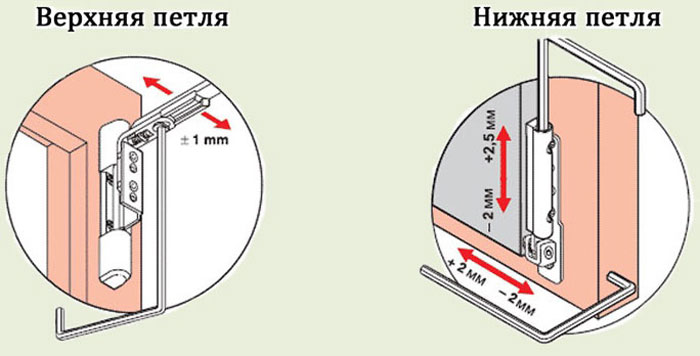
- Calibration of window sashes in the vertical plane is carried out exclusively in the lower hinge.
- Simply open the plastic plug and insert the hexagon into the slot provided for this purpose at the top of the hinge.
- If you turn it clockwise, the door will go up, and if you turn it counterclockwise, it will go down.
Also, the pressing modes of the valves can be adjusted using the central pin, since the entire locking mechanism is located around the perimeter, connected, and also centered on it. Moreover, adjusting the eccentrics is very simple; just move the eccentric clockwise to loosen the pressure, and do the opposite to strengthen it. It is clear that the largest range of adjustment and tuning will not exceed the same, good old two millimeters.
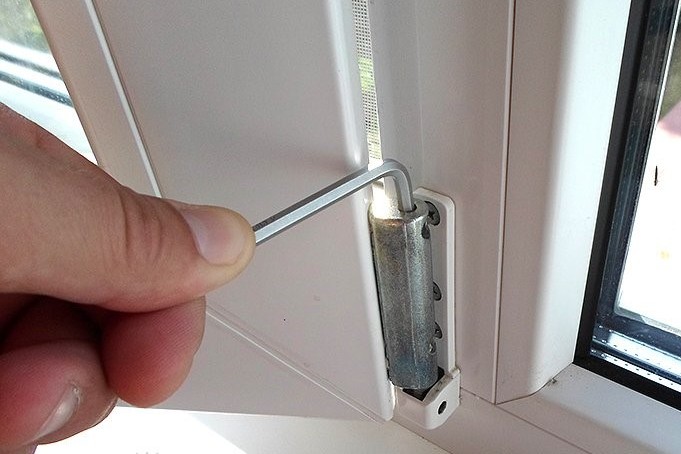
Moreover, the loops can also be adjusted according to the pressure. To do this, you need to twist the screw located on them in the center, which is responsible for this functionality. However, before getting down to business, it’s worth carefully studying how to tighten the sash of a plastic window, the video about which gives a clearer idea. Just a few minutes of your precious time and you can avoid many annoying and stupid mistakes that can even lead to damage to the entire expensive structure.
After prolonged use, plastic windows require maintenance, but it is not always necessary to call a specialist for this. For example, in order to adjust plastic windows yourself, little effort is required, just like for lubrication. Just follow our advice.
Setting up the mechanism
To set up PVC systems you will need:
- 4 mm L-shaped hex key;
- a set of shaped screwdrivers with bits;
- oil for lubricating windows (machine oil will also work);
- crosshead screwdriver;
- pliers.
Seasonal adjustment
If the tightness of the structure is broken, extraneous sounds from the street penetrate into the room, or if there is air flow, you simply need to adjust the window. This is due to the fact that the seal has become distorted under the influence of sunlight or simply lost its elasticity.
Opening the window on the side, you will see iron slots, inside of which there are oval-shaped cylinders - they are called eccentrics or trunnions. They are attached to the window by means of counter eccentrics screwed into it. When the handle is turned, this sash is closely adjacent to the frame. By turning the pins you can adjust the abutment force.
To adjust the plastic window, namely the closing of the sash, you need to turn the protruding part of the trunnion inward. And to weaken it, turn it back to the outside.
Advice! To ensure that the sashes do not jam, and that our advice is carried out without difficulty, it is necessary to lubricate the mechanisms of plastic systems 2-3 times a year. You can purchase special oil for lubrication, or regular machine oil will do. Simply use a syringe to drop a small amount of oil onto the operating mechanism and work the handle of the structure a little.
Depending on the type of system and its manufacturer, the eccentrics are configured differently:
- The cylinders that are located at the end of the window can be rotated using pliers, and then scrolled.
- There are slots on the trunnion - their position can be adjusted using a flat-head screwdriver.
- The pliers will help turn the eccentric.
If the eccentrics cannot be adjusted, then you should not persist. Excessive force can break the structure. To adjust the plastic windows yourself, simply adjust the counter cylinders. They are fixed with two bolts:
- It is necessary to loosen the clamping of the bolts with a hexagon.
- In order to loosen the pressure, you need to move the hook towards the room.
- And to strengthen the fit, move it in the direction of the street.
Adjusting fittings
After adjusting the clamp, you need to adjust the hinged side:
- Remove the trim from the lower canopy - it is plastic.
- Using two visible bolts and one bolt hidden in the canopy, adjust the position of the sash.
Important! It is better to carry out the adjustment with the sash closed, so that you can learn how to adjust without breaking the mechanism. To loosen the pressure, you need to return the hexagon clockwise, and to loosen the pressure, turn it counterclockwise.
The upper segment of the sash is fixed to the so-called scissors. What needs to be configured here in the plastic window:
- Open the door to find the doors you need.
- Next on the end side you will find a lock and press the lever.
- Without releasing it, turn the handle to the window mode.
- The upper corner of the sash moves out of the groove and is fixed on the scissors and the lower canopy.
- Find the head and adjust the pressure on the upper segment of the sash.
- By slightly rotating the bolt head, it is necessary to adjust the contact force using the same eccentric setting.
Horizontal adjustment
Horizontal adjustment of the fittings is carried out in order to remove a slight bevel of the sash and move the frame. To do this, it is better to work only with two loops that fit the hexagon.
Important! The main thing is that the shift does not exceed 2 mm.
If you turn the key clockwise, the frame is pressed against the hinge, and the lower part rises. Likewise, if the key is turned clockwise, the frame moves away and the window lowers.
Vertical adjustment
In this case, the lower part of the loop is adjusted. Remove the trim with the slots for the hex key and, turning clockwise, raise it or, turning counterclockwise, lower it.
Important! Just as with the horizontal adjustment, it is recommended to move it no more than 2 mm.
Blowing in the frame
To solve this problem, you need to find a hexagon groove in the locking cylinders and simply turn the eccentrics so that they press against the seal. You need to repeat this procedure with all the eccentrics that are located along the frame.
Important! Make sure the fit is even.
To ensure the quality service of your plastic windows, apply our advice to them from time to time, and then you will have comfort and peace of mind. Stay tuned for new articles.



















